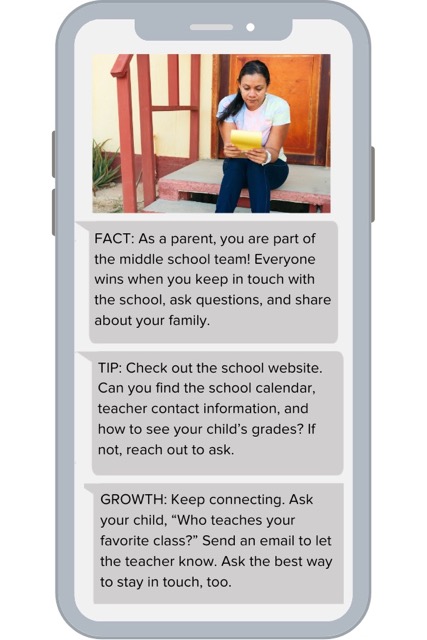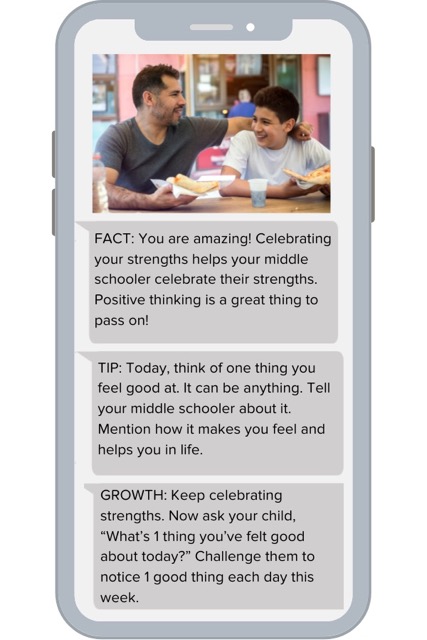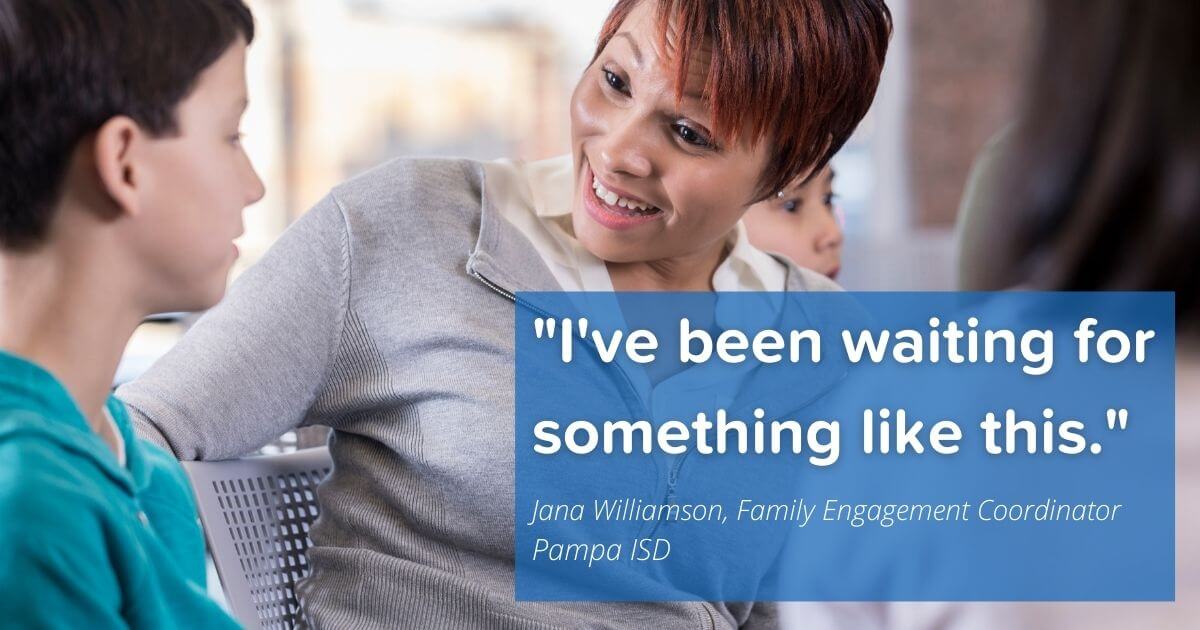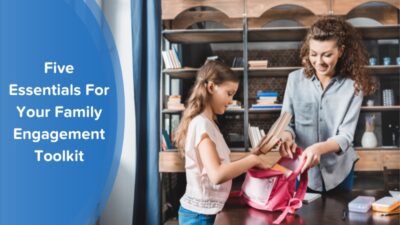By Rebecca Honig, chief content & curriculum officer; edited by Maren Madalyn
Words cannot express how excited I am about middle school family engagement strategies. When I talk about them, I literally burst out of my seat. Just last week, I got so animated explaining why responsive family engagement practices are so crucial to middle school leaders and district administrators that I knocked a glass of water onto my desk. I nearly lost a computer and a half dozen books on adolescent development to water damage.
Needless to say, I have big feelings about middle school — and they are all GOOD. That’s a statement I bet you’ve never heard before!
As a family engagement specialist, I know the power that strong family-school partnerships can offer to educators, and not just those in an elementary school environment.

But when I talk to education leaders that serve older students, it’s clear that this opportunity feels complex and difficult to pin down. In fact, the words “middle school” or “adolescents” rarely seem to go hand in hand with “family engagement” among school administrators.
Here’s the thing, though: responsive family engagement practices are just as important for the 15-year-old as they are for the 5-year-old.
If you’ve read our recent article about this topic, then you’ll know why adolescent family engagement is so critical for pre-teen and teen students, and just how hard it can be. But school leaders also know what research tells us about the many benefits of positive parental involvement in children’s growth — especially for middle and high school students.
The best part is that parents and caregivers of middle school children want to be involved in learning. Better yet — there are evidence-based strategies for educators to support parent involvement at these crucial ages!
So the question becomes: what does positive middle school family engagement look like? And how is it different from approaches in elementary school?

Making middle school family engagement easy, equitable, and accessible
There are so many opportunities for parents and educators to collaborate in building a supportive learning environment not only in the younger years of a student’s life, but well into adolescence and beyond.
ParentPowered has partnered with hundreds of school districts and community organizations to amplify the impact of engagement opportunities for families. We’ve discovered just how magical and crucial these role models are for supporting pre-teen and teen kids with their academic success, social-emotional health, and mental well-being. Our curricula offer families evidence-based strategies to support students’ academic, emotional, and social development — all of which can help school staff deepen essential home-school relationships.
Our team has compiled their favorite activities from our middle school family engagement program specifically, designed to build family involvement across four domains:
- Academic Support
- Social and emotional learning
- Home-school partnerships
- Approaches to parenting
Let’s take a closer look at each domain and what school and community leaders can do to partner more closely with families.
Domain 1: Academic Support
SNAPSHOT: The Academic Supports domain offers parents research-based, developmentally appropriate strategies for supporting their child’s academic learning and goals. It guides families in helping their children reach grade level expectations in Math, Literacy, Science and Social Studies.
We all want parents to support learning throughout all phases of development. Research shows that parents need to do it differently in middle school and beyond. With elementary school students, families might provide more direct support to steer their growth and development. Oftentimes families and educators can also see the effectiveness of building a supportive learning environment, even in informal settings like home.

But this is not the case in middle school. Studies have found that parental involvement in homework directly can actually negatively interfere with student achievement (Cooper, 1989, 2007; Wolf, 1979).
How can families then support their student’s educational goals, if direct involvement has the opposite effect than intended?
According to research, academic socialization is one of the best ways for parents and caregivers to support middle school students with overall academic performance. Nancy Hill and Diana Tyson unpack this in their article on middle school family engagement. Academic socialization means that families:
- Communicate expectations for achievement
- Show that education is valued
- Work with adolescents to determine their occupational and educational aspirations
- Discuss learning strategies
- Make plans and preparations for the future
- Link school subjects with their adolescent’s interests and goals
This ParentPowered activity offers a great opportunity for parents to practice academic socialization at home with their students, focusing on independent homework and study skills:
- FACT: Middle schoolers work to do homework independently. Your support still matters. Asking about homework keeps you connected and builds their independence.
- TIP: After school, ask about your child’s homework. Try, “Do you have homework tonight? Is it due tomorrow? What’s your plan for getting it done?”
- GROWTH: Keep asking about homework. When your child finishes ask, “How did it go? Do you feel good about your work? Do you have any questions for the teacher?”

Domain 2: Social and Emotional Learning (SEL)
SNAPSHOT: The Social-Emotional Learning (SEL) domain aims to increase student success by promoting research-based social and emotional competencies. These lead to middle schoolers building independence, a positive sense of self, emotional regulation and critical relationship skills. Parents play a key role in cultivating these competencies.
Social and emotional skills are critical in middle school and contribute directly to students’ success both inside and outside of their school lives. Recent research shows that adolescents are driven towards five areas of learning and growth. And, they all fall within the SEL domain:
- integrate with peers
- take risks and have new experiences
- learn using emotion, so-called ‘heartfelt goals’
- work out self-identity
- and gain autonomy and independence
Psychologists often sum these drivers up in a single phrase: “I want to belong but I need to stand out at the same time”.
Considering these key drivers, adolescents are often less interested in their families’ direct engagement in school affairs. They are less likely to open up to parents about issues related to social and emotional health and well-being. Parents also see their children’s growing independence as a signal for them to “step back.” In turn, children are left to manage many critical decisions, relationships, and emotions on their own.

And yet, adolescence is also a time when parental support plays a crucial role in children’s development. Kids need families to support their social-emotional learning and development — it encourages them to practice healthy behaviors, use effective communication, and navigate relationships more successfully.
Further, research tells us that teens are uniquely vulnerable to mental health challenges. Many mental health disorders can appear for the first time during adolescence. These include schizophrenia, anxiety, depression, bipolar disorder, and eating disorders.
As is the case with academic learning, families need “just right” activities for supporting social emotional skills in middle school adolescence. As one of our partners explained: “Parents need ways to help [kids] with that transition to independence while letting them know ‘I’m here for you’.”
Take a look at this social-emotional learning activity that parents can use to help prepare their middle schoolers to navigate negative peer pressure by first practicing in a safe and supportive learning environment at home:
- FACT: In middle school kids feel a strong desire to fit in. This can sometimes make it hard for kids to make their own decisions. Practicing with you can help.
- TIP: Ask questions to help your child think about decisions. Try, “What can you do or say if a friend asks you to do something you don’t want to do?”
- GROWTH: Keep talking about decisions. Brainstorm things your child might say to get out of an uncomfortable situation. For example, “I’m not into that. Thanks.”
Domain 3: Home-School Partnership
SNAPSHOT: Home-School Partnerships help build trusting and reciprocal relationships between home and school. These partnerships give families everyday ways to navigate middle school, communicate with educators, lower absenteeism, and advocate for a child’s needs.
Current research in family engagement has shifted the model from participation to partnership. Dr. Karen Mapp, author and creator of the Dual Capacity-Building Framework for Family School Partnerships, recently published a revised version of the framework that places trusted relationships at the top. She did this to show that trusting, reciprocal relationships between home and school are “key for any other partnership work to actually take place.”
But the middle school context can make these home-school relationships exceptionally hard. Middle school parents are often unsure how to be involved. In kind, middle school educators may not know exactly how to deepen adolescent family engagement in school beyond existing practices like parent-teacher conferences.

As a result, educators can struggle to establish the kind of trusting relationships necessary to drive strategies for equitable family engagement. Families need clear points of entry to understand what is happening within their child’s school. Educators must foster open and reciprocal communication between schools and families. This investment is well worth the effort as it can directly benefit things like school climate in the long run.
Developing home-school partnerships means orienting families around how middle school works, how to access information, how to establish relationships with educators, and how to have a voice within the school community. The activity pictured above is one of our favorite ways to encourage middle school families to stay in touch with their schools.

Domain 4: Approaches to Parenting
SNAPSHOT: In the Approaches to Parenting Domain, we arm parents with information, self-care strategies and reflective practices. This helps them to understand, navigate, leverage, and celebrate the shifts that adolescence brings about in the parent-child relationship. Dr. Michael Rier’s quote is spot-on: “In adolescence, kids basically fire their parents as the managers of their lives and rehire them as consultants.”
ParentPowered often hears from middle school educators that many parents approach this time of their child’s life with a sense of dread and overwhelm.
Not surprising, right?
This mindset can make middle school particularly hard for parents to navigate. And, it can make middle school family engagement itself even harder for school staff as well. But mindsets can shift with the right support.
As Dr. Jacob Towery, adjunct clinical instructor in the Stanford Department of Psychiatry, has done extensive research on this. He explains, “By challenging yourself with new experiences and perspectives, you can form new neural connections — or mindsets — at any point in life.”

Shifting family mindsets around the middle school years is key to successful and responsive family engagement practices. By offering strategies and reflective practices to rebuild a strength-based view of adolescence, educators create a crucial opportunity for parents to reimagine middle school learning for the better. This helps parents experience adolescence as an exciting time for building the skills and capacities that lead children into adulthood. It also reinforces confidence that they as parents can still be positive role models for their children — even as their kids deepen their independence.
Another valuable resource that supports a mindset shift is an effective self-care strategy. These help families navigate the ups and downs that come with any period of development and change, especially those happening in middle school adolescence.
ParentPowered loves communication with families that celebrates adolescence as a time of discovery, rapid learning, and growth — one in which parents play a key role. Here’s one of our team’s favorite messages that help middle school parents navigate this new stage of their relationship with their children:
- FACT: No matter what school was like for you, you can support your middle schooler! Just asking questions and listening has a HUGE impact on their learning!
- TIP: After school, ask about things your child has been reading. Try, “What’s something you read in school this week? What did you think about it? Why?”
- GROWTH: Keep asking and listening. Ask your child to show you something they recently completed in math. Say, “Can you tell me about how you figured this out?”

The curriculum I need as a middle school mom
I started this post by telling you just how excited I am about middle school family engagement and the incredible potential it offers to school, family, and community engagement efforts. But I saved a very personal reason for last. I myself am a parent of a middle school child (and another one who was there very recently).
Experiencing middle school family engagement firsthand literally changed my life.
I see my pre-teen and teen children differently. I have new ways to interpret their emotions, support their learning, and listen openly as they share about their friendships. I’m more patient now, better at supporting them as they take healthy risks and grow their independence. I feel like a better parent.
This is why educators and families alike need middle school family engagement. Adolescent students need their families to be engaged. When middle school families partner with their schools, everyone in the school community thrives. And it’s all good!

About the author
Rebecca Honig is the Chief Content and Curriculum Officer at ParentPowered. She has authored numerous curricula, parent guides, and children’s storybooks for Sesame Workshop, Scholastic, Disney, Compass Learning, PBS, WGBH, HITN, Nickelodeon, Mo Willems, and The Norman Rockwell Museum. She has also served as a Curriculum and Content Specialist for Sesame Street and spent ten years teaching in public, private, and after school programs. Rebecca has a Master’s Degree in Early Childhood Education from Bank Street.





